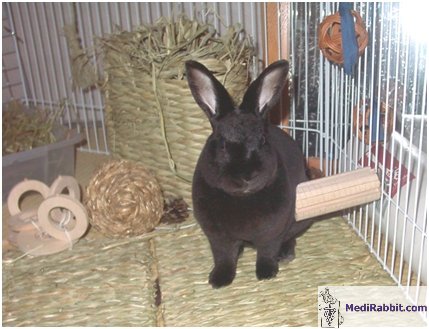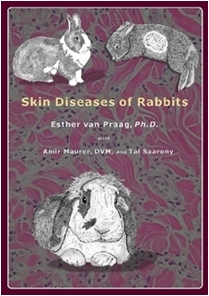Self-mutilating
behavior in rabbits
Esther van Praag Ph.D.
|
MediRabbit.com is
funded solely by the generosity of donors. Every
donation, no matter what the size, is appreciated and will aid in the
continuing research of medical care and health of rabbits. Thank you |
Some rabbits engage in self-mutilation to
the point of severely injuring themselves. This behavior can include chewing
the skin down to the bone, and can lead to the loss of a digit. Rather than
diagnosing self-mutilation as a psychotic problem, possible causes should be
examined and ruled out when a rabbit shows this behavior.
Clinical
signs
Causes include: 1.
Hypersensitive reaction. This involves the immune
system, and is difficult to assess. Such reaction can be triggered by
medication, e.g. intra-muscular injections of ketamine/xylazine
can cause skin irritation, itching and pain, 3 days post-injection. 2.
Infestation of the skin by parasites, such as fur
mites, burrowing mites or rodent mites causing severe itching of the skin. 3.
Atopy, or hereditary allergic reaction, which leads
to pruritus/itchiness of the skin. 4.
Frustration in non-castrated female or male rabbits,
driven by hormones to build a nest or find a partner respectively. 5.
Contact dermatitis - inflammation of the skin or
rash, caused by contact with an irritating or allergy-causing substance. 6.
Neurological disease, e.g., compression of a nerve
due to the presence of an hematoma, mass, injury. 7.
Presence of a foreign body in the fur, e.g. seeds
from grass, oat, burrs or awns (bristle-like appendages found on grasses)
that causes irritation, itchiness of the skin and – depending on the
location, pain. Compulsive self-mutilating
behavior has additionally been linked to environmental factors (e.g.
boredom), and to genetic predisposition in specific breeds of rabbits. These
rabbits start to mutilate the pruritic skin of their digits, more commonly in
late summer and autumn (hormonal problem ?).
Histological studies ruled out the presence of skin disease, bacterial,
fungal or parasitic infection, or neurological problems. When genetic
predisposition is determined as the cause, the condition is treated with psychotic
drugs. F. Iglauer, C. Beig, J. Dimigen, S. Gerold, A. Gocht,
A. Seeburg, S. Steier and F. Willmann. Hereditary compulsive self-mutilating behaviour in laboratory rabbits. Lab Anim 1995;29:385-393 During the last few years an
increasing number of cases of extensive automutilation
has been observed in a rabbit breeding colony of
Checkered crosses. Digits and pads of the front feet were traumatized. No
other behavioural abnormalities or signs of disease
were evident. Self-mutilation was seen both in stock, breeding and
experimental animals, in rabbits kept singly in cages and in those housed in
groups on the ground, in rabbits kept in different buildings and under the
care of different staff members. This behavioural
abnormality of Checkered crosses has also been observed in animals after
being placed into other institutions or private homes. No evidence of an
agent responsible for the occurrence of self-injury could be found with
parasitological, mycological, histological, clinical or haematological
examination. Twelve to 16 animals are affected yearly in a colony varying in
size between 130 and 230 rabbits. Following complete healing,
relapses occurred up to 3 times per year, on either the same or the opposite
front foot. In the last 21 cases episodes of automutilation
could be regularly interrupted with the dopamine antagonist, haloperidol.
Similar signs of automutilation were never seen in
animals of another breeding line kept in the same building and under the same
conditions nor in animals brought in from other breeding colonies. A relatively
high coefficient of inbreeding can be presupposed in this 15-year-old
breeding colony of Checkered crosses. A genetic predisposition for the behavioural anomaly described appears very likely.
Treatment
The
treatment will depend on the cause of the self-mutilating behavior. Often,
the administration of a pesticide (e.g. ivermectin) has solved the problem,
even when no skin parasites or their eggs were detected after a skin scraping
or adhesive tape test. Neutering
the rabbit will help fight sexual frustration, and regulate other behavioral
problems such as spraying and marking territory. Boredom
can easily be dealt with by giving the rabbit toys, opportunities to exercise
and explore its environment, cardboard to tear, branches to chew, hay to play
with and eat, etc. Compulsive
self-mutilating behavior can be brought under control with the administration
of the tranquilizer haloperidol (0.2-0,4 mg/kg,
BID).
Acknowledgement
Thanks are due to Tal Saarony, for
the permission to use pictures of Motek and Gozal, and for her critical
reading. Thank you to Gozal, Motek, Sniffy,
Grijsje, and Stampi for their patience and their cooperation in taking the
numerous pictures.
For detailed information on self-mutilation in
rabbits, “Skin Diseases of Rabbits”, by E. van Praag, A. Maurer and
T. Saarony 408
pages, 2010. References
Beyers TM, Richardson JA, Prince MD. Axonal degeneration
and self-mutilation as a complication of the intramuscular use of ketamine
and xylazine in rabbits. Lab Anim
Sci. 1991; 41(5):519-520. Iglauer F, Beig C, Dimigen J, Gerold S, Gocht A, Seeburg A, Steier S, Willmann F.
Hereditary compulsive self-mutillating behaviour in laboratory rabbits. Lab Anim. 1995;
29(4):385-393. Vachon P. Self-mutilation in rabbits following
intramuscular ketamine-xylazine-acepromazine
injections. Can Vet J. 1999; 40(8):581-582. |
e-mail: info@medirabbit.com























